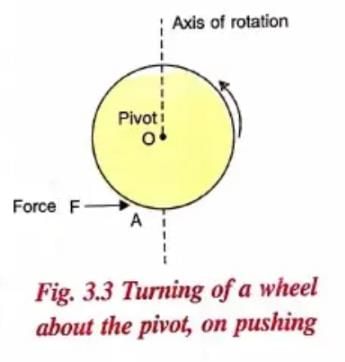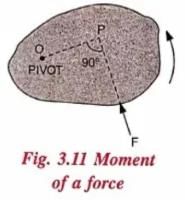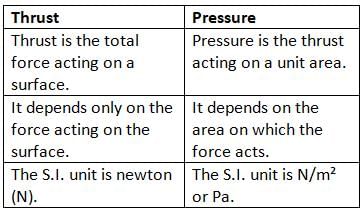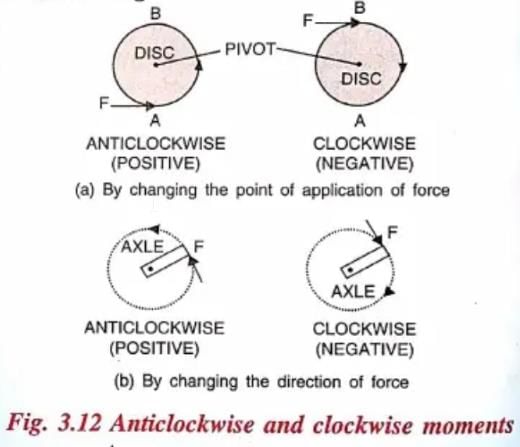Force and Pressure Chapter Notes | Physics for Grade 12 PDF Download
Introduction
In this chapter, we will learn about force and pressure, which are important ideas in physics. A force is a push or pull that can change the way things move or their shape. For example, when you kick a ball, you apply a force to make it move. Pressure is how much force is applied on a certain area. If you press your finger on a balloon, the force on that small area creates pressure. We will explore how force and pressure work in different situations, like on land, in liquids, and even in the air around us. Let’s understand these concepts with simple examples and facts!
Force
- A body that does not change its position compared to its surroundings is at rest.
- A body that changes its position compared to its surroundings is in motion or a moving body.
- Force is a push or pull that can cause different effects on a body.
- Force can make a body that is at rest start moving.
- Force can make a moving body stop.
- Force can change the speed of a moving body, making it move faster or slower.
- Force can change the direction of a moving body.
- Examples of force making things move, stop, or change direction:
- A grass roller at rest starts moving when pulled.
- A fielder stops a moving ball by catching it.
- A moving car slows down when brakes are applied on it.
- A push on a swinging girl makes her swing faster.
- When a player hits a ball with a hockey stick, the ball’s direction changes.
- Force can also change the size or shape of a body if the body cannot move freely.
- Examples of force changing size or shape:
- Stretching a rubber string makes its length increase.
- Squeezing a tube of gum changes its shape.
We define force as: Force is that cause which changes the state of a body (either the state of rest or the state of motion) or it changes the size or shape of the body.
Note:
- Force does not change the mass of the body on which it is applied.
- We cannot see a force, but we can see or feel its effects.
- A force is described by its magnitude (strength) and direction.
- A force is shown by an arrow (→). The length of the arrow shows the magnitude (strength), and the arrowhead shows the direction of the force.
Unit of Force
- The S.I. unit of force is called the newton (N).
- This unit is named after the scientist Sir Isaac Newton, who did a lot of research work on force.
- One newton (1 N) is the force that makes a body of mass 1 kg move with an acceleration of 1 m/s².
- We can write this as: 1 N = 1 kg × 1 m/s².
- The force of gravity on a body is called its weight.
- The weight of a body depends on where it is (like on Earth or another place).
- For example, the force of gravity on a body of mass 1 kg on Earth is 1 kgf (kilogram force).
- In other words, 1 kgf = 10 N (nearly).
- So, the unit of force can also be kilogram force (kgf) or gram force (gf).
- We can write: 1 kgf = 1000 gf.
- Also, 1 kgf = 10 N (nearly), and 1 N = 100 gf (nearly).
- For example, if two newtons (2 N) is the force, it means 2 N = 200 gf.
- In other words, one newton (1 N) is the force that we need to hold a mass of 100 g with our palm.
Did You Know?
- A body where the space between its particles does not change when a force is applied is called a rigid body. If the space between particles changes, it is called a non-rigid body.
- When force is applied to a rigid body, it can only cause the body to move or change its motion. But when force is applied to a non-rigid body, it can cause both a change in size or shape and a change in motion.
Turning Effect of a Force
- When a force is applied on a body that can turn around a fixed point, it creates a turning effect.
- The fixed point is called the pivot point or axis of rotation.
- For example, when a ball is pushed, it moves straight (Fig. 3.2).

- But if the ball is tied to a point O and pushed, it moves around that point O (Fig. 3.3).
- The turning effect happens because the ball is tied and cannot move straight.

- Another example: When we push a door, it turns around its hinges (the pivot point).
- The door opens or closes depending on the direction of the push.
Factors Affecting Turning of a Body
The turning effect of a force on a body depends on two things:
- The strength of the force used. The stronger the force applied, the greater the turning effect on the body.
- The distance between the pivot point and the point where the force is applied. The farther the force is applied from the pivot point, the greater the turning effect on the body.
Some Examples in Daily Life
- Opening a door: Pushing the handle (far from the hinges) requires less force than pushing near the hinges.
- Using a wrench: A longer wrench makes it easier to loosen a tight bolt because the force is applied farther from the pivot.
- Seesaw: The turning effect depends on the weight (force) and the distance from the pivot where people sit.
- Bottle opener: Applying force at the end of the handle increases the turning effect to remove the cap.
- Steering wheel: Turning a car’s steering wheel uses the turning effect to rotate the wheels.
Moment of Force
The moment of force is the turning effect of a force on a body that can rotate around a pivot point.
The moment of force depends on two things:
- The magnitude (strength) of the force applied.
- The perpendicular distance of the force from the pivot point (the point around which the body turns).

- For example, if a force F is applied on a body at point P, and the pivot point is O (Fig. 3.11):
- The perpendicular distance from point O to the line of the force is OP.
- The body will turn around point O in a direction (clockwise or anticlockwise).
- If the body cannot turn (because it is fixed), the moment of force is still there, but the body does not move.
- We can write the moment of force as:
- Moment of force = Force × Perpendicular distance from the pivot point O.
- Or, Moment of force = F × OP.
Units of Moment of Force
- The S.I. unit of the moment of force is newton meter (N m).
- This is because the moment of force is calculated as force (in newtons) × distance (in meters).
- The C.G.S. unit of the moment of force is dyne centimeter (dyne cm).
- This is because the moment of force is calculated as force (in dynes) × distance (in centimeters).
- We know that: 1 N = 10⁵ dyne and 1 m = 100 cm.
- So, 1 N m = 10⁵ dyne × 100 cm = 10⁷ dyne cm.
- For example, if a force of 1 N is applied at a perpendicular distance of 1 m from the pivot point:
- Moment of force = 1 N × 1 m = 1 N m.
- In another example, if a force of 1 kgf is applied at a perpendicular distance of 1 m:
- We know 1 kgf = 10 N (nearly).
- So, moment of force = 10 N × 1 m = 10 N m.
- In another example, if a force of 1 gf is applied at a perpendicular distance of 1 cm:
- We know 1 N = 100 gf (nearly) and 1 m = 100 cm.
- So, we first convert gf to N and cm to m:
- 1 gf = 0.01 N and 1 cm = 0.01 m.
- Moment of force = 0.01 N × 0.01 m = 0.0001 N m.
Did You Know?
- A body can turn in two directions: anticlockwise (like the hands of a clock moving backward) or clockwise (like the hands of a clock moving forward).
- The direction of rotation depends on where the force is applied and the direction of the force.
- For example, in Fig. 3.12, the body turns anticlockwise when the force is applied on one side.
- The body turns clockwise when the force is applied on the other side.
Pressure
Thrust
- When a force is applied on a surface, it creates a thrust (a push) on that surface.
- The thrust on a surface divided by the area of the surface is called pressure.
- In simple words, pressure is the force applied per unit area.
- Pressure depends on two things:
- The force applied.
- The area of the surface on which the force is applied.
- We can write the formula for pressure as:
- Pressure = Force ÷ Area.
- The S.I. unit of pressure is newton per square meter (N/m²), also called pascal (Pa).
- The C.G.S. unit of pressure is dyne per square centimeter (dyne/cm²).
- We know that 1 N = 10⁵ dyne and 1 m² = 10⁴ cm².
- So, 1 N/m² = 10⁵ dyne ÷ 10⁴ cm² = 10 dyne/cm².
- When a body is placed on a surface, it exerts a thrust equal to its weight on that surface.
- The unit of thrust is the same as the unit of force: kilogram force (kgf), gram force (gf), or newton (N).
- The units of force are related as:
- 1 kgf = 1000 gf.
- 1 kgf = 10 N (nearly).
- 1 N = 100 gf (nearly).
The Effect of Thrust
- Thrust means force, and its effect depends on the area where it is applied.
- If the area is smaller, the effect of thrust is bigger.
- If the area is larger, the effect of thrust is smaller.
- Examples:
- If you stand on loose sand, your feet sink deep because the area of your feet is small, so the thrust has a big effect.
- If you lie down on the same sand, you don’t sink much because the area of your body is larger, so the thrust has a smaller effect.
Definition of Pressure
- Pressure is the thrust (force) per unit area.
- The formula for pressure is: Pressure = Thrust / Area
- In short, P = F / A
- Here, P is pressure, F is force (thrust), and A is area.
Unit of Pressure
- The S.I. unit of pressure is newton per meter square (N/m²), also called pascal (Pa).
- 1 pascal (Pa) means 1 newton of force on 1 meter square area.
- So, 1 Pa = 1 N/m²
- The bigger unit of pressure is kilo pascal (kPa).
- 1 kPa = 1000 Pa
- If thrust is measured in kgf and area in cm², then pressure is in kgf/cm².
- The atmospheric pressure (air pressure) is generally measured in a unit called atm.
- 1 atm = 76 cm of mercury column (we will learn more later).
- Another unit of pressure is 1 atm = 1.013 × 10⁵ Pa.
Factors Affecting Pressure
Pressure depends on two main factors:
- Dependence on Area: For a given force, pressure is inversely proportional to the area. A smaller area results in higher pressure. For example, a needle’s sharp tip (small area) pierces skin easily, while a blunt pencil tip requires more force.
- Dependence on Thrust (Force): Pressure is directly proportional to the force applied. A larger force increases pressure if the area remains constant. For instance, standing on one foot increases pressure compared to standing on both feet.
Examples of Pressure in our Daily Life
(A) Decrease in area increases the pressure
- A nail or a board pin has a sharp, pointed end and a flat, blunt end. When we apply force on the pointed end, it creates more pressure because the contact area is small, so it goes deeper into the surface.
- Cutting tools like a blade, knife, or axe have very sharp edges. These sharp edges have a small contact area, so the pressure is high, making cutting easier.
- Pointed heels on footwear create more pressure on the ground than regular flat sandals. This is why it’s harder to walk on a muddy road with pointed heels compared to a tarred road.
- Narrow-heeled sandals of a girl hurt more than broad-heeled shoes of a boy. This happens because the girl’s narrow heel has a smaller area, so it exerts more pressure than the boy’s broader heel.
(B) Increase in area decreases the pressure
- Heavy trucks have six to eight tyres instead of four. More tyres increase the contact area with the ground, which reduces the pressure on the ground.
- A camel can walk on sand more easily than a horse. This is because a camel has broader feet than a horse, so the camel’s feet create less pressure on the sand, making it easier to walk. A horse’s feet, with less area, create more pressure and tend to sink into the sand, making walking harder.
- Skiers use long, flat skis to slide over snow. The large surface area of the skis reduces pressure on the snow, helping them slide smoothly.
- Tanks have wide tracks instead of regular wheels. These tracks increase the contact area with the ground, reducing pressure and preventing the tank from sinking into the ground.
- Foundations of buildings are kept wide so the weight of the building spreads over a larger area. This reduces the pressure on the ground and prevents the building from sinking.
- A porter carries heavy loads on his head by increasing the contact area. This reduces the pressure of the load on his head.
- School bags and shopping bags have broad straps or belts. The larger contact area of the straps reduces the pressure on the hand or shoulder.
- Wide wooden sleepers are placed below railway tracks. This increases the contact area, so the pressure on the ground becomes less.
Difference Between Thrust and Pressure

Liquid Pressure
A solid puts pressure on a surface because of its weight. Liquids also have weight, so they put pressure on the container they are kept in. A solid only puts pressure on the surface at its bottom. A liquid puts pressure not only on the bottom of its container but also on the sides, meaning in all directions.
Factors Affecting Liquid Pressure
Two things affect the pressure at a point in a liquid:
- Liquid Pressure Increases with the Height of the Liquid Column: The higher the liquid column above a point, the more pressure it creates at that point.
- Liquid Pressure Increases with Increase in Density of Liquid: Denser liquids create more pressure at the same height. For example, mustard oil is denser than water, so mustard oil creates more pressure than water at the same height.
Consequences of Liquid Pressure
- Dams: Dams are thicker at the base to withstand the high pressure of water at greater depths.
- Submarines: Submarines are built strong to resist the high pressure of water at deep ocean levels.
- Hydraulic systems: Liquid pressure is used in car brakes and lifts to transmit force effectively.
- Water tanks: Elevated water tanks use liquid pressure to supply water to homes.
- Deep-sea diving: Divers wear suits to protect against high liquid pressure at depth.
Atmospheric Pressure
- Gases like air also create pressure because of their weight.
- The earth is surrounded by a layer of air called the atmosphere, which is about 200 km high.
- The pressure of this air on the earth’s surface is called atmospheric pressure.
- Atmospheric pressure means the pressure of air around us.
- It is about 100,000 N/m² (or 10⁵ N/m²).
- We don’t feel it because our body has blood pressure inside, which balances the atmospheric pressure outside.
- Atmospheric pressure changes with height:
- At higher altitudes (like mountains), the air is thinner, so atmospheric pressure is less.
- At sea level, the air is thicker, so atmospheric pressure is more.
Standard Value of Atmospheric Pressure
- At sea level on the earth’s surface, the atmospheric pressure is 76 cm of mercury column, which is equal to 1 atm or 1.013 × 10⁵ Pa.
- Atmospheric pressure decreases as you go higher above the earth’s surface because the air gets thinner.
Some Examples in Daily Life to Show the Existence of Atmospheric Pressure
Here are some daily life examples that show atmospheric pressure exists:
- When you suck a drink with a straw, the air pressure inside the straw decreases, and the atmospheric pressure outside pushes the drink into your mouth.
- When you blow air into a balloon, the air inside the balloon has more pressure than the atmospheric pressure outside, so the balloon expands.
- Ink gets filled into a fountain pen because of atmospheric pressure pushing the ink inside.
- Water is drawn up from a well by a pump because atmospheric pressure helps push the water up.
- A syringe works because atmospheric pressure pushes the liquid into the syringe when the plunger is pulled up.
- Rubber suckers (like hooks in the kitchen) stick to the wall because atmospheric pressure holds them against the wall.
- It is hard to take out oil from a sealed tin if only one hole is made. If you make another hole, atmospheric pressure helps the oil come out easily.
- Lizards can stick to walls because their feet have suction pads that use atmospheric pressure to hold them in place.
- Astronauts wear special suits to protect themselves from low atmospheric pressure in space, where there is no air.
- Nose bleeding can happen at high altitudes because the atmospheric pressure is low, and the blood pressure inside the body becomes higher, causing the nose to bleed.
Points To Remember
- A force is a push or pull that acts on a body which is free to move.
- A force can change the state of rest or motion of a body, and it can also change the size or shape of the body.
- A force is measured by both its magnitude (size) and direction.
- The direction of a force is shown by an arrow.
- The S.I. unit of force is newton (symbol N) and its gravitational unit is kilogram force (kgf) where 1 kgf = 10 N (nearly).
- If a force is applied on a body which can turn around a pivoted point, it is called the turning effect of a force.
- The turning effect of a force depends on two factors: (i) the magnitude (size) of the force, and (ii) the perpendicular distance of the force from the pivoted point.
- A bigger force or a larger perpendicular distance from the pivoted point creates a larger turning effect.
- The product of the force and the perpendicular distance from the pivoted point is called the moment of force.
- Moment of force = Force (F) × perpendicular distance (d).
- The S.I. unit of moment of force is newton meter (symbol Nm).
- If a body turns clockwise due to the force, the moment of force is positive.
- If a body turns anticlockwise due to the force, the moment of force is negative.
- Thrust is the force that acts normally on a surface.
- Thrust is the same as force but acts straight on a surface.
- The effect of thrust depends on the area where it acts.
- The units of thrust are kgf, gf, and newton (N).
- 1 kgf = 1000 gf, 1 kgf = 10 N (nearly), and 1 N = 100 gf (nearly).
- Pressure is defined as the thrust per unit area, i.e., Pressure P = Thrust F / Area A.
- Pressure depends on: (a) the area of the surface on which the thrust acts, (b) the magnitude (size) of the thrust acting on the surface.
- Smaller the area, more the pressure exerted by the thrust.
- Larger the area, less the pressure exerted by the thrust.
- The S.I. unit of pressure is newton per meter² (symbol N/m² or Pa).
- Liquids and gases exert pressure in all directions.
- Liquids exert pressure not only at the bottom but also on the sides of the container in which they are kept.
- Pascal’s law states that the pressure exerted by a liquid at a depth is the same in all directions.
|
142 videos|312 docs|132 tests
|
FAQs on Force and Pressure Chapter Notes - Physics for Grade 12
| 1. What is the definition of force and how is it applied in daily life? |  |
| 2. What are the units of force, and how are they measured? |  |
| 3. What is meant by the turning effect of force, and can you give an example? |  |
| 4. What factors affect the turning of a body? |  |
| 5. How is pressure defined, and what is its significance in everyday applications? |  |






















